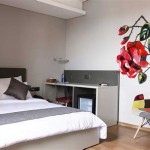Living Room White Wall Decoration Ideas
White walls in a living room provide a versatile canvas for various design styles and decorative elements. The neutrality of white allows for flexibility in accent colours, furniture choices, and overall ambiance. Successfully decorating a living room with white walls involves strategic planning and an understanding of how different elements interact within the space. This article explores several key strategies and ideas for enhancing the aesthetic appeal of a living room featuring white walls.
Strategic Use of Colour and Texture
While white walls offer a clean and minimalist backdrop, incorporating colour and texture is crucial to prevent the room from feeling sterile or bland. A well-balanced approach involves selecting a cohesive colour palette and introducing tactile elements that add depth and visual interest.
One method is to introduce colour through furniture. A vibrant sofa or a set of armchairs in a bold hue can serve as a focal point in the room. Alternatively, neutral-toned furniture can be paired with colourful cushions, throws, and rugs to create a more subtle effect. The choice depends on the desired level of visual impact and the overall design aesthetic.
Texture plays a significant role in adding dimension to a white-walled living room. Consider incorporating textiles with varied textures, such as chunky knit blankets, velvet cushions, or woven rugs. Natural materials like wood, rattan, and stone can also contribute to the textural richness of the room. A wooden coffee table, a rattan armchair, or a stone fireplace surround can add warmth and visual interest.
Artwork is another effective way to introduce both colour and texture. A large, abstract painting with bold colours and thick brushstrokes can serve as a statement piece, while a collection of smaller framed prints can create a more layered and curated look. Consider the frames themselves as part of the decorative scheme, opting for different materials and finishes to add further textural interest.
Plants are a natural and refreshing way to introduce colour and texture. Greenery not only adds visual appeal but also contributes to a sense of calm and well-being. A variety of plant types, from large floor plants to smaller potted succulents, can be strategically placed throughout the room to create a lush and inviting atmosphere. Consider the placement carefully, ensuring that plants receive adequate light and are visually balanced within the space.
Lighting fixtures also present an opportunity to introduce colour and texture. A statement chandelier with intricate details or a set of colourful table lamps can add a touch of personality and visual interest. Consider the material and finish of the lighting fixtures, opting for options that complement the overall design scheme. Metal finishes like brass or copper can add warmth, while glass or ceramic fixtures can introduce a more delicate and refined aesthetic.
Maximizing Natural Light and Artificial Illumination
White walls have the advantage of reflecting light, which can make a room feel brighter and more spacious. However, maximizing both natural light and artificial illumination is essential to create a well-lit and inviting living room.
To enhance natural light, avoid obstructing windows with heavy curtains or blinds. Opt for sheer or lightweight fabrics that allow sunlight to filter through while still providing some privacy. Mirrors can also be strategically placed to reflect light and create the illusion of more space. Position mirrors opposite windows to maximize their effectiveness.
Artificial lighting should be layered to provide both ambient and task lighting. Ambient lighting provides overall illumination for the room, while task lighting is focused on specific areas, such as reading nooks or work spaces. A combination of overhead lighting, floor lamps, and table lamps can create a well-balanced and functional lighting scheme.
Consider the colour temperature of the light bulbs. Warm white light creates a cozy and inviting atmosphere, while cool white light provides a more crisp and modern feel. Choose the colour temperature that best suits the overall design aesthetic of the room. Dimmable light fixtures allow for greater control over the lighting levels, allowing you to adjust the ambiance to suit different activities and moods.
Accent lighting can be used to highlight specific features of the room, such as artwork or architectural details. Spotlights or track lighting can be used to draw attention to focal points and create visual interest. Consider the placement of accent lights carefully to ensure that they effectively illuminate the desired features without creating harsh shadows.
Incorporate reflective surfaces throughout the room to further enhance the lighting. Glass coffee tables, metal accents, and mirrored furniture can all help to bounce light around the space, making it feel brighter and more open. Consider the placement of these reflective surfaces carefully to avoid creating glare or unwanted reflections.
Pay attention to the shadows created by furniture and accessories. Avoid placing large pieces of furniture in front of windows, as this can block natural light and create dark corners. Instead, arrange furniture to maximize the flow of light throughout the room. Consider the placement of lamps and other light fixtures to minimize shadows and create a more evenly lit space.
Creating Focal Points and Zones
A well-designed living room typically features one or more focal points that draw the eye and create a sense of visual interest. Additionally, dividing the room into distinct zones can help to create a more functional and organized space.
A fireplace is a natural focal point in many living rooms. Decorate the mantel with a curated selection of objects, such as candles, vases, and artwork. Consider painting the fireplace surround a contrasting colour to make it stand out against the white walls. A large piece of artwork can also serve as a focal point, especially if it is strategically placed above a sofa or console table.
A feature wall can be created by painting one wall a different colour or applying wallpaper. This can add drama and visual interest to the room. Choose a colour or pattern that complements the overall design scheme. A gallery wall, consisting of a collection of framed prints and photographs, can also serve as a focal point and add a personal touch to the room.
Divide the living room into distinct zones based on function. A conversation area can be created around a sofa and coffee table, while a reading nook can be established with a comfortable armchair and a floor lamp. Define these zones with rugs, furniture placement, and lighting.
Rugs can be used to anchor furniture groupings and define different areas of the room. A large area rug can be placed under a sofa and armchairs to create a cohesive conversation area. Smaller rugs can be used to define individual zones, such as a reading nook or a play area for children.
Furniture placement can also be used to define zones. Arrange furniture to create clear pathways and separate different areas of the room. Consider the flow of traffic and ensure that furniture is arranged in a way that allows for easy movement. Use bookshelves or screens to visually separate different zones and create a sense of privacy.
Lighting can be used to further define zones. Use different types of lighting to create distinct atmospheres in different areas of the room. For example, a reading nook can be illuminated with a warm and focused floor lamp, while a conversation area can be illuminated with ambient overhead lighting.
Accessories can be used to personalize each zone and reflect the individual needs and preferences of the occupants. Consider adding personal touches, such as family photos, travel souvenirs, and handcrafted items. These personal touches can help to create a warm and inviting atmosphere and make the living room feel like a true reflection of the people who live there.
A consistent design theme throughout the zones can maintain the visual harmony in the living room. While each zone can serve a different function, a unifying element, such as a consistent colour palette or style of furniture, ensures that all the areas of the room feel connected and cohesive.

20 Best White Walls Ideas House Interior Living Room Decor Design

40 White Room Decorating Ideas For 2025 Gorgeous Interiors
:max_bytes(150000):strip_icc()/living-room-ideas-5194639-hero-a99a77f61b9b4e368c62ca603ab45322-f1eab80714ee48fe913f82d7928c33cc.jpeg?strip=all)
20 White Living Room Ideas That Are Clean And Chic
:strip_icc()/101765312-54a8dad491584d4da70138bc24e5a7f0.jpg?strip=all)
What Colors Go With White Walls How To Decorate

Best White Living Room Design Decor Ideas For Monochrome Spacejoy

20 Elegant White Living Room Ideas For Every Home Style

How To Decorate A Room With White Walls Decoist

35 Best White Living Room Ideas For Decorating

Make Your Ed House A Home The Lovely Drawer Minimalist Living Room Designs
:strip_icc()/cdn.cliqueinc.com__cache__posts__268171__emily-henderson-target-design-advice-268171-1537395824654-image.700x0c-3bf5dbafc49045e5b14c9ad244891f94.jpg?strip=all)
40 Best Living Room Wall Décor Ideas
Related Posts







